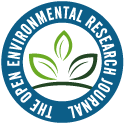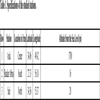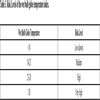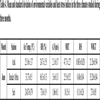- Home
- About Journals
-
Information for Authors/ReviewersEditorial Policies
Publication Fee
Publication Cycle - Process Flowchart
Online Manuscript Submission and Tracking System
Publishing Ethics and Rectitude
Authorship
Author Benefits
Reviewer Guidelines
Guest Editor Guidelines
Peer Review Workflow
Quick Track Option
Copyediting Services
Bentham Open Membership
Bentham Open Advisory Board
Archiving Policies
Fabricating and Stating False Information
Post Publication Discussions and Corrections
Editorial Management
Advertise With Us
Funding Agencies
Rate List
Kudos
General FAQs
Special Fee Waivers and Discounts
- Contact
- Help
- About Us
- Search
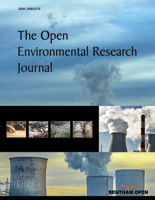
The Open Environmental Research Journal
Formerly: The Open Ecology Journal
ISSN: 2590-2776 ― Volume 16, 2023
- New Journal Website
- Journal Home
- Editorial Board
- Board Recruitment Workflow
- Instructions for Authors
- Plagiarism Prevention
- Fabricating and Stating False Information
- Research Misconduct
- Post Publication Discussions and Corrections
- Allegations from Whistleblowers
- Advertising Policy
- Short Guide
- Editorial Policies
- Publishing Ethics and Rectitude
- Quick Track Option
- Reviewer Guidelines
- Guidelines for Guest Editors
- Publication Fee
- Publication Cycle - Process Flowchart
- Archiving Policies
- Special Issues
Feasibility of Relative Strain Index (RSI) for the Assessment of Heat Stress in Outdoor Environments: Case Study in Three Different Climates of Iran
Mehdi Asghari1, Gholamabbas Fallah Ghalhari2, Marzieh Abbasinia3, Fahimeh Shakeri2, Reza Tajik1, *, Mohammad Javad Ghannadzadeh4
Abstract
Objectives:
Different indices are used to evaluate heat stress in outdoor environments. This study was aimed at examining the applicability of the Relative Strain Index (RSI) to the assessment of heat stress in several climates of Iran.
Methods:
Based on the Köppen classification, three different climates were studied. Arak, Bandar Abbas, and Sari were selected as representative of semi-arid and cold climates, hot and dry, and Mediterranean, respectively. The data recorded by the meteorological organization, including air temperature, relative humidity and air velocity were surveyed during 15-year period in three different climates. The RSI index was calculated by the formula. Also, the Wet Bulb Globe Temperature (WBGT) index was computed using a model presented by the Australian Bureau of Meteorology (ABM). Data were analyzed using SPSS v.22, descriptive statistics, Pearson correlation coefficient, and linear regression.
Results:
The mean RSI index in summer of the 15 years in Arak was 0.033 ± 0.33, in Bandar Abbas 0.54 ± 0.6 and for Sari was 0.17 ± 0.05. A high correlation was found between environmental variables and RSI index in three different climates. As well, there was a positive and significant correlation between both RSI and WBGT indices in three different climates (R2>0.96).
Conclusion:
The RSI index is a simple and empirical index and can be used for the evaluation of heat stress along with other indices. The index estimates the situation more than expected to be stressful in warm and dry conditions. So, it is not a useful index for hot and dry climates such as Bandar Abbas.
Article Information
Identifiers and Pagination:
Year: 2020Volume: 13
First Page: 11
Last Page: 18
Publisher Id: TOECOLJ-13-11
DOI: 10.2174/1874213002013010011
Article History:
Received Date: 23/07/2019Revision Received Date: 05/02/2020
Acceptance Date: 07/02/2020
Electronic publication date: 05/06/2020
Collection year: 2020
open-access license: This is an open access article distributed under the terms of the Creative Commons Attribution 4.0 International Public License (CC-BY 4.0), a copy of which is available at: https://creativecommons.org/licenses/by/4.0/legalcode. This license permits unrestricted use, distribution, and reproduction in any medium, provided the original author and source are credited.
* Address correspondence to this author at the Department of Occupational Health Engineering, School of Public Health, Arak University of Medical Sciences, Arak, Iran; Tel: +989121915049; E-mail: t.rezatajik@yahoo.com
| Open Peer Review Details | |||
|---|---|---|---|
| Manuscript submitted on 23-07-2019 |
Original Manuscript | Feasibility of Relative Strain Index (RSI) for the Assessment of Heat Stress in Outdoor Environments: Case Study in Three Different Climates of Iran | |
1. INTRODUCTION
Heat stress and its effects in outdoor environments have become one of the biggest health challenges. If due to high ambient temperatures people cannot balance between the generated and received heat by the body and lost heat, the heat generated is greater than the lost heat, due to which heat stress can occur (Asghari et al., 2017bAsghari, M, Nassiri, P, Monazzam, MR, Golbabaei, F, Arabalibeik, H, Shamsipour, A & Allahverdy, A (2017) Weighting Criteria and Prioritizing of Heat stress indices in surface mining using a Delphi Technique and Fuzzy AHP-TOPSIS Method. J Environ Health Sci Eng, 15, 1.
[http://dx.doi.org/10.1186/s40201-016-0264-9] [PMID: 28101366] , Nassiri et al., 2018bNassiri, P, Reza Monazzam, M, Golbabaei, F, Abbasinia, M, Chavoshi, M, Taheri, F & Asghari, M (2018) Exposure to heat stress in the workplace: A systematic review. Salamat-i Kar-i Iran, 15., Nassiri et al., 2017Nassiri, P, Monazzam, MR, Golbabaei, F, Dehghan, SF, Rafieepour, A, Mortezapour, AR & Asghari, M (2017) Application of Universal Thermal Climate Index (UTCI) for assessment of occupational heat stress in open-pit mines. Ind Health, 55(5), 437-43.
[http://dx.doi.org/10.2486/indhealth.2017-0018] [PMID: 28804096] , Nassiri et al., 2018aNassiri, P, Monazzam, MR, Golbabaei, F, Shamsipour, A, Arabalibeik, H, Mortezapour, AR, Teimori, G & Asghari, M (2018) Applicability of Modified Discomfort Index (Mdi) in outdoor occupational environments: A Case study of an open pit mines in Tehran province. Salamat-i Kar-i Iran, 15, 136-45.).
According to the definition of the United Nations Framework Convention, climate change is any variation in climatic conditions that differs with atmospheric compounds in the past and directly or indirectly affects the human activity. Climate change and global warming, produced by greenhouse gases, have caused heat wave especially in the warm seasons, to put many people at risk of hyperthermia and other heat-related complications. Not only workers, but also all the people in the community especially the elderly and children are at risk, who are vulnerable (Heidari et al., 2018Heidari, H, Rahimifard, H, Mohammadbeigi, A, Golbabaei, F, Sahranavard, R & Shokri, Z (2018) Validation of air enthalpy in evaluation of heat stress using Wet Bulb Globe Temperature (wbgt) and body core temperature: A case study in a hot and dry climate. Health And Safety At Work, 8, 81-92.). Moreover, the military and athletes are among the high-risk groups exposed to heat (Asghari et al., 2017aAsghari, M, Nassiri, P, Monazzam, M, Golbabaei, F, Arabalibeik, H & Shamsipour, A (2017) The development of an empirical model for estimation of the sensitivity to heat stress in the outdoor workers at risk. Ann Med Health Sci Res, 7, 77-84.).
In recent decades, the heat waves have caused severe health outcomes in the world. For example, the Athens heatwave resulted in about 2,000 deaths in 1987 (Yazdanpanah et al., 2015Yazdanpanah, H, Saleifard, O & Golshahi, J (2015) The effect of heat waves on cardiovascular patients (Case Study: Bandar Abbas). Spatial Planning, 5, 45-62.), Europe about 70000 deaths in 2003 (Robine et al., 2008Robine, J-M, Cheung, SLK, Le Roy, S, Van Oyen, H, Griffiths, C, Michel, J-P & Herrmann, FR (2008) Death toll exceeded 70,000 in Europe during the summer of 2003. C R Biol, 331(2), 171-8.
[http://dx.doi.org/10.1016/j.crvi.2007.12.001] [PMID: 18241810] ), Russia 55000 deaths in 2010 (Barriopedro et al., 2011Barriopedro, D, Fischer, EM, Luterbacher, J, Trigo, RM & García-Herrera, R (2011) The hot summer of 2010: redrawing the temperature record map of Europe. Science, 332(6026), 220-4.
[http://dx.doi.org/10.1126/science.1201224] [PMID: 21415316] ), among others are the examples of the effects of heat waves on human health. Each year in the United States, on average 400 deaths are directly related to heat, particularly among people over 65 years (Yazdanpanah et al., 2015Yazdanpanah, H, Saleifard, O & Golshahi, J (2015) The effect of heat waves on cardiovascular patients (Case Study: Bandar Abbas). Spatial Planning, 5, 45-62.).
Different indices are used to measure and evaluate heat stress. More than sixty heat stress indices have been presented by researchers for evaluation that are divided into three groups of rational, empirical, and direct indices (Nassiri et al., 2018aNassiri, P, Monazzam, MR, Golbabaei, F, Shamsipour, A, Arabalibeik, H, Mortezapour, AR, Teimori, G & Asghari, M (2018) Applicability of Modified Discomfort Index (Mdi) in outdoor occupational environments: A Case study of an open pit mines in Tehran province. Salamat-i Kar-i Iran, 15, 136-45.). In most assessments, we have tried to evaluate the amount of heat stress using meteorological information such as air temperature, relative humidity, air flow velocity (wind), solar radiations, and/or a combination of them. Among these parameters, temperature and relative humidity have more influence on human health and well-being, for this reason, most human thermal comfort models have been developed based on these two parameters (de Freitas and Grigorieva, 2017de Freitas, CR & Grigorieva, EA (2017) A comparison and appraisal of a comprehensive range of human thermal climate indices. Int J Biometeorol, 61(3), 487-512.
[http://dx.doi.org/10.1007/s00484-016-1228-6] [PMID: 27568190] ).
The Wet Bulb Globe Temperature (WBGT) is one of the most reliable and standard indices that is widely accepted and used worldwide (Mazlomi et al., 2017Mazlomi, A, Golbabaei, F, Farhang Dehghan, S, Abbasinia, M, Mahmoud Khani, S, Ansari, M & Hosseini, M (2017) The influence of occupational heat exposure on cognitive performance and blood level of stress hormones: A field study report. Int J Occup Saf Ergon, 23(3), 431-9.
[http://dx.doi.org/10.1080/10803548.2016.1251137] [PMID: 27852154] ). Despite the widespread use of the WBGT index globally, it has limitations. Factors such as the expensive measuring device for many industries, especially small and medium ones, require accurate calibration of the measuring sensors particularly the radiation temperature sensor; furthermore, the long relative equilibrium time for temperature stability of measuring sensors have caused other existing indices to be considered and used (Budd, 2008Budd, GM (2008) Wet-Bulb Globe Temperature (WBGT)-its history and its limitations. J Sci Med Sport, 11(1), 20-32.
[http://dx.doi.org/10.1016/j.jsams.2007.07.003] [PMID: 17765661] ).
An equation has been provided by the Australian Meteorological Agency for this index, which is based on temperature and water vapor pressure variables. In this equation, the water vapor pressure is estimated by taking into account temperature and relative humidity variables (Lemke and Kjellstrom, 2012Lemke, B & Kjellstrom, T (2012) Calculating workplace WBGT from meteorological data: A tool for climate change assessment. Ind Health, 50(4), 267-78.
[http://dx.doi.org/10.2486/indhealth.MS1352] [PMID: 22673363] ). It should be noted that it has been used in various studies (Kakamu et al., 2017Kakamu, T, Wada, K, Smith, DR, Endo, S & Fukushima, T (2017) Preventing heat illness in the anticipated hot climate of the Tokyo 2020 Summer Olympic Games. Environ Health Prev Med, 22(1), 68.
[http://dx.doi.org/10.1186/s12199-017-0675-y] [PMID: 29165162] , Leroyer et al., 2018Leroyer, S, Bélair, S, Spacek, L & Gultepe, I (2018) Modelling of radiation-based thermal stress indicators for urban numerical weather prediction. Urban Climate, 25, 64-81.
[http://dx.doi.org/10.1016/j.uclim.2018.05.003] ).
One of the indices based on temperature and relative humidity variables (water vapor pressure) for assessing thermal comfort in summer is the Relative Strain Index (RSI). This index was introduced by Lee and Henschel and then Kyle (de Garín and Bejarán, 2003de Garín, A & Bejarán, R (2003) Mortality rate and relative strain index in Buenos Aires city. Int J Biometeorol, 48(1), 31-6.
[http://dx.doi.org/10.1007/s00484-003-0175-1] [PMID: 12756630] , Alfano et al., 2010Alfano, FRDA, Palella, BI & Riccio, G (2010) Thermal environment assessment reliability using temperature—humidity indices. Ind Health, 1008190028-.
[PMID: 20823629] ). The RSI shows the ratio of the amount of required sweat evaporation to the extent of possible evaporation according to the environmental conditions, and also this index is without the unit (de Garín and Bejarán, 2003de Garín, A & Bejarán, R (2003) Mortality rate and relative strain index in Buenos Aires city. Int J Biometeorol, 48(1), 31-6.
[http://dx.doi.org/10.1007/s00484-003-0175-1] [PMID: 12756630] ). To interpret the index, five levels are considered. This index can be used when the air temperature is less than or equal to 35°C. Moreover, even with changes in relative humidity at temperatures below 26°C, the index values are always at comfort or convenience level (Alessandro and de Garín, 2003Alessandro, A & De Garín, A (2003) A study on predictability of human physiological strain in buenos aires city. Meteorol Appl, 10, 263-71.
[http://dx.doi.org/10.1017/S1350482703003062] ).
It should be noted that the assessment of climate variables for calculation of heat stress indices is usually costly and time consuming. Therefore, weather data can be used to solve this problem in environmental assessments of outdoor environments. Meteorological data have the advantage of continuous recording, providing a cheap and comprehensive data bank at our disposal. There is a possibility of access to meteorological variables and calculation of momentous indices in most cases (Farhang Dehghan et al., 2015Farhang Dehghan, S, Mehri, A, Golbabaei, F & Beheshti, MH (2015) Heat stress assessment in outdoor workplaces of a hot arid climate based on meteorological data: a case study in qom, Iran. Journal Mil Med, 17, 89-95.). Variables such as dry temperature, wet temperature, relative humidity, air velocity, and amount of solar radiations are measured at most meteorological stations, and these data can easily be used to assess heat stress in different environments. On the other hand, in most studies, there are high correlations between measured and meteorological data, which is a solid reason for using this data for environmental topics (Hajizadeh et al., 2016Hajizadeh, R, Mehri, A, Jafari, S, Beheshti, M & Haghighatjou, H (2016) Feasibility of esi index to assess heat stress in outdoor jobs. Journal Of Occupational And Environmental Health, 2, 18-26.).
In the present study, at first, the correlation between RSI index and climate variables affecting heat stress including air temperature, relative humidity, Mean Radiant Temperature (MRT) and air velocity were determined. Also, the correlation between this index and the Wet-Bulb Globe Temperature (WBGT) as a standard index was investigated. This study aimed at the feasibility of RSI to the assessment of heat stress in outdoor environments along with the WBGT index using meteorological data in three different climates of Iran.
2. METHODOLOGY
Based on the Köppen classification, there are 10 different climates in Iran. According to this classification, 80, 16.7, 3.2% of Iran's climate have dry, moderate, and cold weather, respectively. In this study, three cities from three different climates were selected and evaluated. a) Arak was selected as representative of the central part of Iran from the semi-arid and cold climatic; b) Bandar Abbas was representative of the southern coast of the country from the hot and dry climatic region, and c) Sari was representative of the northern coast of the country from the Mediterranean climatic (Fallah Ghalhari et al., 2016Fallah Ghalhari, G, Esmaili, R & Shakeri, F (2016) Assessing the seasonal variability of thermal stresses during the last half century in some climatic zones of Iran. Salamat va Muhit, 9, 233-46.). The locations studied are shown in Fig. (1 ) and their geographic characteristics in Table 1. The required data to calculate the heat stress indices including mean temperature (°C), relative humidity (percentages on daily scale) for 15 years during the period of 2000-2014 was obtained from the meteorological organization of Iran.
) and their geographic characteristics in Table 1. The required data to calculate the heat stress indices including mean temperature (°C), relative humidity (percentages on daily scale) for 15 years during the period of 2000-2014 was obtained from the meteorological organization of Iran.
 |
Fig. (1) The geographic locations of the studied regions. |
As mentioned before, other variables such as air velocity and MRT can influence heat stress. Air flow velocity (m/s) was obtained from the meteorological organization. The MRT parameter expresses the thermal effect of solar radiation and ambient temperature on human and represents the temperature of a uniform surface from a hypothetical site that surrounds the subject. Given that this parameter is not directly measured, it is calculated according to equation 1 (Blażejczyk, 2011Blażejczyk, K (2011) Assessment of regional bioclimatic contrasts in Poland. Miscellanea Geographica-Regional Studies On Development, 15, 79-91.
[http://dx.doi.org/10.2478/v10288-012-0004-7] ).
 |
(1) |
R' = Solar radiation absorbed by the naked man.
Lg = Radiation of the Earth
La = Returned Radiation
Sh = Emission factor for the human body equal to 0.95
S = fixed by Stefan–Boltzmann (5.667×10-8 W. m-2. K-4).
RayMan software was used to calculate this variable (Fallah Ghalhari et al., 2015Fallah Ghalhari, G, Mayvaneh, F & Shakeri, F (2015) Evaluation of thermal comfort and human health using Universal Thermal Climate Index (utci) case study: Kurdistan province. Salamat va Muhit, 8, 367-78.).
2.1. Relative Strain Index (RSI)
RSI index is used to assess the heat stress of outdoor environments. It is obtained from two variables of air temperature (°C) and water vapor pressure (hectopascal) (Equation 2). Due to the fact that at some stations there is no access to water vapor pressure variable, therefore this parameter is determined by using the two variables of air temperature and relative humidity, according to Equation 3 (Ionac and Ciulache, 2007Ionac, N & Ciulache, S (2007) The bioclimatic stress in Dobrudja. Present Environment And Sustainable Development, 1, 168-78., Kyle, 1992Kyle, W (1992) Summer and winter patterns of human thermal stress in Hong Kong. In: Kyle, W., Chang, CP., (Eds.), Proceedings of the 2nd Int, Conference on east asia, and western pacific meteorology and climate, Hong Kong 557-83.):
 |
(2) |
T: Temperature (°C)
E: water vapor pressure (hPa)
 |
(3) |
T: Temperature (°C)
RH = Relative humidity (%)
Table 2 shows the RSI index classification in five levels.
2.2. Wet Bulb Globe Temperature (WBGT)
Unfortunately, due to the lack of measurement of globe temperature (Tg) by meteorological stations, it is not possible to report the heat stress conditions based on the WBGT index provided by the International Organization for Standardization (ISO) (Equation 4). Therefore, the model presented by the Australian Bureau of Meteorology (ABM) was used in this study (Equation 5) (Lemke and Kjellstrom, 2012Lemke, B & Kjellstrom, T (2012) Calculating workplace WBGT from meteorological data: A tool for climate change assessment. Ind Health, 50(4), 267-78.
[http://dx.doi.org/10.2486/indhealth.MS1352] [PMID: 22673363] ). This model has been used in several studies abroad (Kakamu et al., 2017Kakamu, T, Wada, K, Smith, DR, Endo, S & Fukushima, T (2017) Preventing heat illness in the anticipated hot climate of the Tokyo 2020 Summer Olympic Games. Environ Health Prev Med, 22(1), 68.
[http://dx.doi.org/10.1186/s12199-017-0675-y] [PMID: 29165162] , Leroyer et al., 2018Leroyer, S, Bélair, S, Spacek, L & Gultepe, I (2018) Modelling of radiation-based thermal stress indicators for urban numerical weather prediction. Urban Climate, 25, 64-81.
[http://dx.doi.org/10.1016/j.uclim.2018.05.003] ) and inside the country (Farhang Dehghan et al., 2015Farhang Dehghan, S, Mehri, A, Golbabaei, F & Beheshti, MH (2015) Heat stress assessment in outdoor workplaces of a hot arid climate based on meteorological data: a case study in qom, Iran. Journal Mil Med, 17, 89-95., Hajizadeh et al., 2016Hajizadeh, R, Mehri, A, Jafari, S, Beheshti, M & Haghighatjou, H (2016) Feasibility of esi index to assess heat stress in outdoor jobs. Journal Of Occupational And Environmental Health, 2, 18-26.).
 |
(4) |
Where,
Tnw, Ta and Tg are natural wet temperature, dry temperature and globe temperature in terms of (°C), respectively (Nassiri et al., 2017Nassiri, P, Monazzam, MR, Golbabaei, F, Dehghan, SF, Rafieepour, A, Mortezapour, AR & Asghari, M (2017) Application of Universal Thermal Climate Index (UTCI) for assessment of occupational heat stress in open-pit mines. Ind Health, 55(5), 437-43.
[http://dx.doi.org/10.2486/indhealth.2017-0018] [PMID: 28804096] ). The water vapor pressure in equation 5 is obtained from equation 6 (Lemke and Kjellstrom, 2012Lemke, B & Kjellstrom, T (2012) Calculating workplace WBGT from meteorological data: A tool for climate change assessment. Ind Health, 50(4), 267-78.
[http://dx.doi.org/10.2486/indhealth.MS1352] [PMID: 22673363] ).
 |
(5) |
 |
(6) |
Ta = Average air temperature (°C)
RH = Relative humidity (%)
E = water vapor pressure (hPa)
The classification of this index by the American College of Sports Medicine (ACSM) is presented in Table 3, which is categorized in four levels (Epstein and Moran, 2006Epstein, Y & Moran, DS (2006) Thermal comfort and the heat stress indices. Ind Health, 44(3), 388-98.
[http://dx.doi.org/10.2486/indhealth.44.388] [PMID: 16922182] ).
Data analysis was performed using Microsoft Office Excel 2010 and SPSS 22 software, descriptive statistics, Pearson correlation coefficient and linear regression were used.
3. RESULTS
The mean of environmental variables such as air temperature, relative humidity, and also RSI and WBGT indices of the three studied climates in the summer months are separately presented in Table 4. In the Arak city during the last 15 years, the maximum air temperature was observed in July (28.12 ± 0.65), the maximum relative humidity in June (24.7 ± 1.55), the maximum amount of RSI and WBGT indices was related to July, 0.151 ± 0.013 and 23.26 ± 0.4, respectively.
In the Bandar Abbas city, the maximum air temperature was in July (34.27 ± 0.26), the maximum relative humidity was observed in August (68.38 ± 2.4), and the maximum amount of RSI and WBGT indices was obtained in July (0.6 ± 0.03) and (37.22 ± 0.43), respectively.
In the Sari city, the maximum air temperature was observed in August (27.54 ± 0.57), the maximum relative humidity was related to June (73.8 ± 1.9), the maximum amount of RSI and WBGT indices was obtained in August 0.21 ± 0.02 and 30 ± 0.47, respectively.
Correlation between environmental variables and the studied indices in three different climates are separately shown in Table 5. There is a high correlation between RSI index and air velocity in two hot and dry and, Mediterranean climates. Only in the semi-arid and cold climate, the relationship between the index and the air velocity was not statistically significant (r=-0.056, P>0.05). Between RSI index and air temperature, the variable was obtained at a very high correlation coefficient in semi-dry and cold climate and as well as Mediterranean climate. There was a direct significant correlation between RSI index and relative humidity in hot and dry climate, and in other two climates, an inverse significant relationship was observed. The MRT showed a high correlation with the desired index in the three studied climates, especially in the Mediterranean weather. The WBGT index also had a high correlation coefficient with environmental variables, which was similar to the RSI index. Additionally, there is a very high correlation between RSI and WBGT indices in three different climates. Correlation between the thermal indices in three different climates is shown in Fig. (2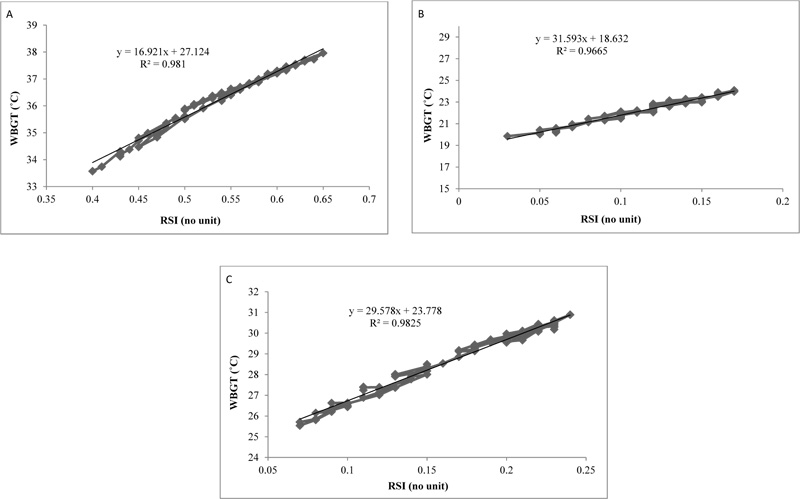 ).
).
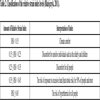
Classification of the relative strain index levels (Blażejczyk, 2011Blażejczyk, K (2011) Assessment of regional bioclimatic contrasts in Poland. Miscellanea Geographica-Regional Studies On Development, 15, 79-91.
[http://dx.doi.org/10.2478/v10288-012-0004-7] ).
 |
Fig. (2) Correlation between the studied indices; A, in a semi-arid and cold climate (Arak); B, in hot and dry climate (Bandar Abbas); C, in the Mediterranean climate (Sari). |
4. DISCUSSION
Exposure to heat stress can cause a wide range of disorders and complications in people and in some cases can cause death (Farhang Dehghan et al., 2015Farhang Dehghan, S, Mehri, A, Golbabaei, F & Beheshti, MH (2015) Heat stress assessment in outdoor workplaces of a hot arid climate based on meteorological data: a case study in qom, Iran. Journal Mil Med, 17, 89-95., Asghari et al., 2018Asghari, M, Nassiri, P, Monazzam, M R, Golbabaei, F, Shamsipour, A A & Arabalibeik, H (2018) Provision of an empirical model to estimate the adaptive capacity of workers at risk of heat stress Health Scope, 7). Moreover, it can reduce the productivity and performance of individuals (Mazloumi et al., 2014Mazloumi, A, Golbabaei, F, Mahmood Khani, S, Kazemi, Z, Hosseini, M, Abbasinia, M & Farhang Dehghan, S (2014) Evaluating effects of heat stress on cognitive function among workers in a hot industry. Health Promot Perspect, 4(2), 240-6.
[PMID: 25649311] ). Therefore, evaluation of this harmful factor in outdoor environments can be considered as a priority. In this regard, different indices are used to assess the heat stress and each of them has advantages and disadvantages (Nassiri et al., 2018aNassiri, P, Monazzam, MR, Golbabaei, F, Shamsipour, A, Arabalibeik, H, Mortezapour, AR, Teimori, G & Asghari, M (2018) Applicability of Modified Discomfort Index (Mdi) in outdoor occupational environments: A Case study of an open pit mines in Tehran province. Salamat-i Kar-i Iran, 15, 136-45.).
In this study, the RSI index along with the WBGT index offered by the Australian Meteorological agency was studied for evaluating several different climates in Iran. Recorded data at the meteorological stations of each region were used to estimate the thermal indices (Heidari et al., 2018Heidari, H, Rahimifard, H, Mohammadbeigi, A, Golbabaei, F, Sahranavard, R & Shokri, Z (2018) Validation of air enthalpy in evaluation of heat stress using Wet Bulb Globe Temperature (wbgt) and body core temperature: A case study in a hot and dry climate. Health And Safety At Work, 8, 81-92.). The results showed that the mean RSI index for 15 years in the summer season for semi-arid and cold climate, hot and dry climate, and Mediterranean climate were 0.123 ± 0.33, 0.54 ± 0.6, and 0.17 ± 0.05, respectively. The highest rate of the index was observed in the cities of Arak and Bandar Abbas in July but in Sari was related in August, which was due to higher temperature parameter in the mentioned months. Given the results of Table 4, in Arak there is a thermal comfort in June, thermal discomfort in July that can be dangerous for susceptible people such as the elderly and children, and in August there is thermal comfort. In Bandar Abbas, there is a risk of hyperthermia for all people in the summer months. In Sari, thermal comfort was also observed in June, and thermal discomfort was related to July and August, which can be dangerous for people who are sensitive to heat. In several studies, the RSI index was investigated, which was similar to the results in the present study, especially in areas where high relative humidity was reported. For example, the relationship between RSI index and mortality in Buenos Aires was studied by de Garín and Bejarán. They displayed that there is a thermal discomfort in 75% of summer days, and for values of RSI greater than 0.2, a sudden death occurred that is indicating influence of the high thermal strain (de Garín and Bejarán, 2003de Garín, A & Bejarán, R (2003) Mortality rate and relative strain index in Buenos Aires city. Int J Biometeorol, 48(1), 31-6.
[http://dx.doi.org/10.1007/s00484-003-0175-1] [PMID: 12756630] ). A study by Eludoyin et al. was designed to evaluate thermal comfort using effective temperature (ET), temperature–humidity index (THI) and RSI index between 1951 and 2009. The mean RSI index was 0.2 (0.18)°C and due to various weather conditions, RSI provided contrasting expressions for thermal comfort in Nigeria. They revealed that the heat stress has increased since 2000 at most of the stations, especially in the south and northwest. The weather conditions were heterogeneous and recommended the analysis of multiple thermal indices (Eludoyin et al., 2014Eludoyin, OM, Adelekan, IO, Webster, R & Eludoyin, AO (2014) Air temperature, relative humidity, climate regionalization and thermal comfort of Nigeria. Int J Climatol, 34, 2000-18.
[http://dx.doi.org/10.1002/joc.3817] ). In another study Abuloye et al. evaluated effective temperature, RSI index and dew point temperature in southwest Nigeria. Air temperature has increased by about 1°C at the most stations between 1961 and 2013. Areas near the Atlantic coast were under the heat stress conditions, which increased since 1991 (Abuloye et al., 2017Abuloye, A, Nevo, A, Eludoyin, O, Popoola, K & Awotoye, O (2017) An assessment of effective temperature, relative strain index and dew point temperature over southwest nigeria. J Climatol Weather Forecasting, 5, 192.).
Ramezani et al. assessed the climate comfort and determined the optimal tourist destination in the Rudsar city using the RSI index during the 10-year period (Ramezani et al., 2018Ramezani, B, Farajzadeh, H & Moradian, R (2018) Study of tourism climate of rudsar city using Relative Pressure Index (Rsi). Scientific Journal Management System, 1, 37-49.). The results showed that the bioclimatic comfort conditions were maintained in the months of April to December. The results of Molanejad study, with the aim of correlation between climate and human thermal comfort, in the urban environment using RSI index showed that northern parts of Tehran had appropriate comfort during hot period, but southern regions had inappropriate comfort. It was predicted that thermal discomfort is exacerbated by increasing the air temperature during the hot months (Molanejad, 2015Molanejad, M (2015) Relations between climate and human comfort in urban environment using neurotic pressure index (Case Study: Tehran City). J Environ Stud (Northborough), 41, 275-82.). The results of our study in the Sari climate confirm the findings of the study by Ramezani et al., and the results of Molanejad study are consistent with the results of this study in two climates of Bandar Abbas and Arak.
Based on the results of this study, the mean WBGT index for Arak city in the summer season was obtained 22.3 ± 1.07, which for Bandar Abbas and Sari cities was 36.4 ± 1 and 28.86 ± 1.47, respectively. In Arak, mean risk levels were obtained in June and August and high-risk levels were achieved in July. In Bandar Abbas, the amounts of every three months of the summer were very high-risk. In Sari, a high risk in June and very high risk in July and August was observed. Considering that the majority of Iran has a hot climate and is located in desert and semi-desert areas (Amiri and Eslamian, 2010Amiri, M & Eslamian, S (2010) Investigation of climate change in Iran. J Environ Sci Technol, 3, 208-16.
[http://dx.doi.org/10.3923/jest.2010.208.216] ), increasing air temperatures in hot seasons can have an influence on the general public and on the performance of outdoor workers (Malakouti and Rahimi, 2014Malakouti, J & Rahimi, H (2014) Investigation heat stress in small enterprise in Qom city. Health And Safety At Work, 3, 59-68., Hajizadeh et al., 2015Hajizadeh, R, Golbabaie, F, Monazam Esmaielpour, M, Mehri, A, Hosseini, M & Khodaparast, I (2015) Assessing the heat stress of brick-manufacturing units’ workers based on wbgt index in qom city. Journal Of Health And Safety At Work,, 4, Jafari et al., 2016Jafari, MJ, Assilian Mahabadi, H, Khodakarim, S & Teimori, GH (2016) Heat stress in an open-pit iron ore mine and its relationship with physiological strain. Health And Safety At Work, 6, 51-62.). Amounts of WBGT greater than 32°C can increase the core body temperature and sweat rate, especially in unacclimatized subjects. With increasing humidity content significantly reducing the time of tolerance, unacclimatized subjects may be at risk for heat-related diseases, if the working plans are not adequately managed (Claassen and Kok, 2007Claassen, N & Kok, R (2007) The accuracy of the wbgt heat stress index at low and high humidity levels. Occupational Health Southern Africa, 13, 12-8.). Moreover, in very hot and high humidity areas, the amount of heat stress using the WBGT index may be estimated less than the actual amount (Bates and Schneider, 2008Bates, GP & Schneider, J (2008) Hydration status and physiological workload of UAE construction workers: A prospective longitudinal observational study. J Occup Med Toxicol, 3, 21.
[http://dx.doi.org/10.1186/1745-6673-3-21] [PMID: 18799015] ).
Here, the RSI and WBGT indices showed the same correlations with environmental variables, so that a positive and significant correlation between both indices and air temperature is found. There was a direct significant correlation between thermal indices and relative humidity in the hot and dry climate, and also an inverse significant relationship was observed in other two climates. The MRT showed a positive and significant correlation with both indices in the three studied climates. As well, between these indices and air velocity variable in the hot and dry climate and the Mediterranean climate were obtained direct and indirect correlations, respectively, and in the semi-arid climate, this relationship was not significant. Additionally, between RSI index and WBGT index a very high correlation was found in the three climates. The highest correlation was related to the Mediterranean climate (r > 0.991). The result indicated that a significant correlation between studied indices in three surveyed climates, shows appropriateness of using the RSI index to assess thermal comfort in different climates. In the study by Alina, bioclimatic indices of RSI, THI, Discomfort Index (DI), and Wind Chill Equivalent Temperature (WCET) showed the same comfort or discomfort conditions in different seasons of the year (Alina, 2016Alina, V (2016) Thermal comfort within oltenia plain Muzeul Olteniei Craiova Oltenia Studii Şi Comunicări Ştiinţele Naturii, 32, 115-21.).
Regarding the advantage of using RSI index, it should be noted that data measured by meteorological organizations can be used to predict and timely announce the state of heat stress in different regions. If preventive management measures are taken by the relevant organizations, the occurrence of stressful conditions and its complications will reduce among exposed people. The low cost for measuring and easy interpretation RSI index is one of its benefits. On the other hand, given the climate change phenomena and global warming in the coming decades, the amount of this index by considering different scenarios of climate change can be predicted. It is hoped that this way steps to maintain and protect the health of individuals can be taken, especially the manpower of outdoor work environments.
CONCLUSION
Based on the results, the RSI index can be used as a simple and empirical index for the evaluation of heat stress along with other indices. Indices based on temperature and humidity are not suitable for hot and dry climates like Bandar Abbas and is recommended to use rational indices for evaluation of heat stress, so that more logical results can be achieved. It should be noted that each of the heat stress indices has its own advantages and disadvantages, and cannot achieve acceptable results by examining an index. At the same time, by evaluating and comparing the indices for a single environment, better and accurate evaluation can be done.
CONSENT FOR PUBLICATION
Not applicable.
AVAILABILITY OF DATA AND MATERIALS
Not applicable.
FUNDING
This study was funded and supported by Arak University of Medical Sciences; Grant no. 3369.
CONFLICT OF INTEREST
The authors declare that they have no conflict of interest, financial or otherwise.
ACKNOWLEDGEMENTS
The authors gratefully acknowledge the assistance provided by the Iran Meteorological Organization.



